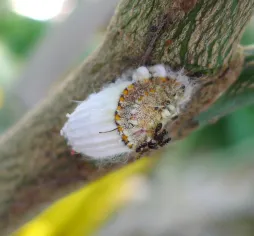Aeonium leucoblepharum, an Aeonium from Africa
While many Aeoniums, such as aeonium canariense virgineum and aeonium haworthii, are native to the Canary Islands, Aeonium leucoblepharum comes from Eritrea, Somalia or Yemen. Before buying your own, find out where it comes from. The foliage differs from country to country.
How to recognize Aeonium leucoblepharum?
A succulent shrub with an upright habit, Aeonium leucoblepharum reaches a height of 75 cm and a spread of 55 cm.
Its highly branched brown stem measures up to two centimetres in diameter. Branches are drooping or creeping. Each branch bears a rosette of leaves at its tip.
The appearance of the foliage varies according to strain and location. Leaves are always thick, with serrated margins. But they can also be obovate or spatulate, and their apex can be more or less pointed. They are green with red margins in the Somali version, or brown or pink in specimens from Yemen. Some leaves have a red or brown line down the center.
Flowers with yellow petals appear in summer. They are grouped on a pyramid-shaped spike.
Aeonium leucoblepharum is not listed as a toxic plant for humans or animals. However, it is not edible. Ingestion of its leaves can cause vomiting, in cats for example.
Our maintenance tips
If you live in a frost-free region, you can plant your Aeonium leucoblepharum in the ground, provided the soil remains dry.
Elsewhere, it's best to opt for a pot culture and bring your Aeonium leucoblepharum into your conservatory or living room when temperatures drop. The good news is that it's in winter, when the plant is growing, that it reveals all its beauty!
Watering
When it's very hot, your plant needs to be watered accordingly, as it goes into vegetative mode to protect itself.
Check that the substrate is dry to the depth of five centimeters before watering. If your plant is thirsty, water with cold or lukewarm water. It's best to use rainwater to provide nutrients. If you don't have any, use mains water.
Empty any stagnant water from the dish to prevent root rot.
Do not water during this period.
Spray
Your aeonium leucoblepharum hates wet foliage. You must not mist the plant.
Repotting
Re-pot your Aeonium leucoblepharum in a pierced pot. Line the bottom with pebbles or clay balls to improve drainage.
Aeonium leucoblepharum appreciate well-drained soil. You can use a substrate for cacti and succulents, or mix garden soil with river sand.
Pour a little potting soil into the pot and plant your specimen. Don't hesitate to push in the stem a third of the way up. This way, the plant will be more stable and produce more roots. Fill with potting soil and press down to remove air bubbles.
Prune
To encourage the growth of your Aeonium leucoblepharum, prune regularly.
Remove dried leaves.
Cut back flower stems when flowers have wilted. If you use a tool, make sure it's clean and sharp.
Plantation
Your Aeonium leucoblepharum loves light and hates humidity. Plant it in the sun and in a place where water won't stagnate after a shower, such as an embankment or the top of a slope.
Dig a hole twice the size of the root ball. Place pebbles or clay balls at the bottom to improve drainage. Plant your Aeonium leucoblepharum and fill in with garden soil. You can add sand to lighten the soil. Press down to remove air bubbles.
Cutting
Cutting is carried out during the strong growth phase, generally in spring and early summer.
The mother plant produces shoots. Separate them with a clean knife. Leave to dry for 24 to 48 hours in the open air, until a wedge forms at the base.
Prepare a perforated pot. Place clay balls or pebbles in the bottom for drainage. Then fill with a light substrate, such as potting soil for cacti and succulents. Use a pencil or pick to make a hole.
Plant your Aeonium leucoblepharum. Bury the stem about a third of the way up. This way, your plant will form more roots and be more stable. But don't bury the leaves! Place your cutting in a bright room with a temperature of between 15 and 18°.
Wait a few weeks before watering, to allow the roots to form.
Disease / Threat
Information
| Family | Crassulaceae - Crassulaceae |
| Type | Aeonium - Aeonium |
| Species | Aeonium leucoblepharum - Aeonium leucoblepharum |
| Lifecycle | Perennial |
| Foliage | Evergreen |
| Exposures | |
| Substrats | |
| Planting methods |
Open ground In pots In tubs |
| Categories | |
| Tag |
Fritillary |
| Origin |
East Africa |
| Hardiness (USDA) | 10b |
| Leaf color |
|
| Flower color |
|
Discover plants from the same family
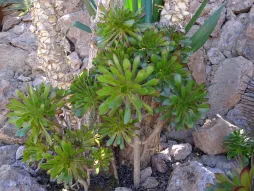
Aeonium arboreum
Discover
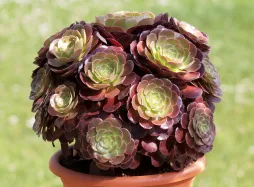
Aeonium atropurpureum
Discover
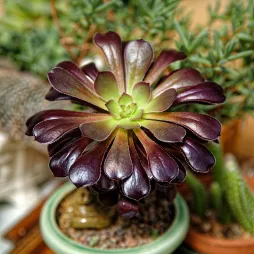
Aeonium 'Zwartkop'
Discover
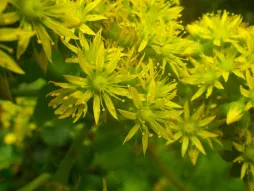
Aeonium cuneatum
Discover













